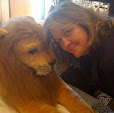Last year I started reading John Steinbeck again and discovered that his travel book, Travels with Charley, was inspired by Robert Louis Stevenson's Travels With a Donkey in the Cevennes, the discovery of which meant that I needed to Stevenson's travelogue before tackling Steinbeck's...and that's how it ended up on my Classics Challenge list for this year.
I just finished in time for November's Autumn monthly Classics Challege blog prompt, posted yesterday. Katherine asked participants to select a piece of music that reflects the book.
Since Stevenson's trip in the Cevennes, a mountain range in south-central France, occurred in 1878, and his account of it was published in 1879, my first impulse was towards something that evoked French peasant music and that sounded vaguely Victorian.
Something like the theme song from the BBC series based on Peter Mayle's A Year in Provence:
This definitely evokes the villages, the landscapes, and the people that Stevenson encounters during the twelve days that he hikes along with Modestine, the pretty little donkey who carries his supplies and initally gives him such trials until he learns to handle her...and until she is no longer in heat, a little fact that Stevenson didn't grasp but that subsequent readers recognized.
This definitely evokes the villages, the landscapes, and the people that Stevenson encounters during the twelve days that he hikes along with Modestine, the pretty little donkey who carries his supplies and initally gives him such trials until he learns to handle her...and until she is no longer in heat, a little fact that Stevenson didn't grasp but that subsequent readers recognized.
In honor of Modestine and the affection with which Stevenson ultimately has for his beast of burden when he sells her after the trip, I have to go with the third movement ("On the Trail") from Ferdie Grofe's Grand Canyon Suite.
Here's a bit from another YouTube video that explains what Grofe was doing in this movement:
* On the Trail is the best-known of the movements of the Grand Canyon Suite, the aural report of the day riding on the back of a pack donkey (imitating its clip-clop), beginning and ending with a great "hee-haw". A violin cadenza is used to wonderful effect. The principal theme of this movement, which is presented by the horns, and later, trombones, serves as the central motif of the suite.
While Stevenson walked alongside Modestine, or behind her beating her with a stick, or in front, pulling her, instead of riding her, I'm sure the clip-clops of her hooves were part of the universe of sensations this trip provided.
Travels With a Donkey was not the best travel book I've read, nor is it the best Stevenson book I've read, but it does mark the beginning of his earnest work to become an established and popular writer. It's an early work and reflects the personal struggles that he was facing at the time. It is fitting that during a physical journey he writes about his movement away from the faith of his father, toward his writing career, away from Scotland and England, and toward America, where the woman he loves has gone to sort out how she and Stevenson can be together.
The travelogue begins self-consciously, with Stevenson feeling his way and trying to figure out what to write about, but by the end the prose settles down and the descriptions of the landscape, his experiences of camping alone under the stars, and his belief in the healing power of love make this book definitely worth reading. Here's a lovely passage near the end, and this alone makes me want to go on and read the other travelogue he wrote just after Travels With a Donkey, Amatuer Emigrants, about his trip to America.
Our two shadows--mine deformed with the knapsack, hers comically bestridden by the pack--now lay before us clearly outlined on the road, and now, as we turned a corner, went off into the ghostly distance, and sailed along the mountain like clouds. From time to time a warm wind rustled down the valley, and set all the chestnuts dangling their bunches of foliage and fruit; the ear was filled with whispering music, and the shadows danced in tune. And next moment the breeze had gone by, and in all the valley nothing moved except our travelling feet. On the opposite slope, the monstrous ribs and gullies of the mountain were faintly designed in the moonshine; and high overhead, in some lone house, there burned one lighted window, one square spark of red in the huge field of sad nocturnal colouring.


an excellent post and great choice of music! thanks for sharing.
ReplyDeletehere's mine:
A Classics Challenge - September prompt
Your post is very insightful Jane!
ReplyDelete! Though I would not say that all great travel books are really about internal journeys, it sound like this one is about that to some degree.
That is a great passage that you quoted at the end.
The perfect choice! Really enjoyed reading your post too.
ReplyDeleteGreat post Jane. I read a good travelogue recently you might be interested in (probably like it more than me) A Sense of Direction by Gideon Lewis-Kraus
ReplyDeleteThe clip-clop in the music can't help but bring a smile. I like 3:50 when the twittering of birds and maybe dawn seems to break. :) Thanks for sharing, Jane!
ReplyDelete